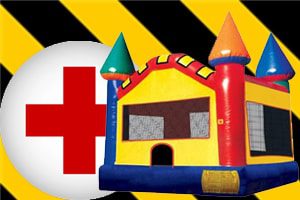
The increasingly popular and ubiquitous nature of inflatable bounce houses and moonwalks has led to a rise in injuries suffered, mostly by children, while using them. Bounce houses are a staple at many summertime parties. It needn’t even be fair weather these days for a bounce house to be seen. They inflate indoors and are […]
 The increasingly popular and ubiquitous nature of inflatable bounce houses and moonwalks has led to a rise in injuries suffered, mostly by children, while using them.
The increasingly popular and ubiquitous nature of inflatable bounce houses and moonwalks has led to a rise in injuries suffered, mostly by children, while using them.
Bounce houses are a staple at many summertime parties. It needn’t even be fair weather these days for a bounce house to be seen. They inflate indoors and are available at the consumer retail and rental levels for nominal fees, comparatively. This means millions more children every year will enter a bounce house and since 1995, according to a new study, bounce house injuries have increased 15-fold.
The more common these bounce houses have become means more children are likely to use one not under the supervision of an adult or someone who is certified to ensure that a bounce house is used safely. The most common injuries reported while using bounce houses and inflatable moonwalks are bone fractures and muscle injuries.
The lead author of the study on bounce house injuries, Dr. Gary A. Smith of the Center for Injury Research and Policy at Nationwide Children’s Hospital in Columbus, Ohio, said if bounce house injuries were an infectious disease, it would dominate headlines for weeks. According to a U.S. News & World Report report on the release of this study from the leading consumer advocacy group, at least 31 children per day (on average) are injured while playing in a bounce house.
Injury totals have spiked in the last few years examined for the study, which was between 1995 and 2010. The study is being published in the December edition of the journal, Pediatrics.
The average age of a child injured using a bounce house is just 7.5, the study found. Twenty-eight percent of injuries reported were bone fractures, the most common among all injuries. Strains and sprains accounted for 27 percent of all injuries. Concussions, other head injuries, and minor cuts were more commonly reported among boys than they were for girls. About 3 percent of all injuries suffered in bounce houses and moonwalks required hospitalization or emergency care for treatment and observation.
Most of the injuries suffered while using bounce houses and moonwalks occurred when children collided together or fell on top of one another. Falls prompted most of all these injuries.
Even repeated warnings from consumer safety officials and advocacy groups on the dangers of bounce houses have not slowed the rate of injuries. Study authors believe that increased awareness of their dangers and parents becoming more aware of their dangers and how to prevent injuries will help to slow the rate of injuries children suffering using bounce houses.


